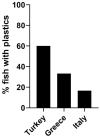Plastic Contamination in Seabass and Seabream from Off-Shore Aquaculture Facilities from the Mediterranean Sea
- PMID: 37987441
- PMCID: PMC10660701
- DOI: 10.3390/jox13040040
Plastic Contamination in Seabass and Seabream from Off-Shore Aquaculture Facilities from the Mediterranean Sea
Abstract
We characterized the presence of plastics in different organs of the gilthead seabream (Sparus aurata) and European seabass (Dicentrarchus labrax) from some off-shore aquaculture facilities of the Mediterranean Sea. Plastics were detected in 38% of analyzed fish. Higher contamination was observed in fish from Turkey and Greece with respect to Italy, without significant differences between the geographical areas. Plastics accumulated mostly in the gastrointestinal tract and, to a lower extent, in the muscle, which represents the edible part of fish. Based on the particle detected, a maximum amount of 0.01 plastic/g wet weight (w.w.) can occur in muscles, suggesting a low input for humans through consumption. A large portion of the particles identified was represented by man-made cellulose-based fibers. The characterization of the polymeric composition suggests that plastics taken up by fish can have land-based and pelagic origins, but plastics can be introduced also from different aquaculture practices.
Keywords: ecology; ecotoxicology; farmed fish; marine pollution; microfibers; seafood.
Conflict of interest statement
The authors declare no conflict of interest.
Figures



References
LinkOut - more resources
Full Text Sources

